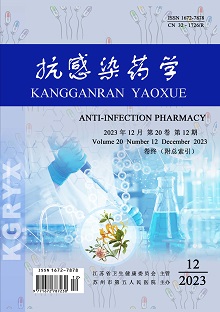WANG Ji-yun, WANG Dan, WU Wen-li, ZHANG Yan-jie, MA Jing, WANG Nan, JING Jing, LU Zhao-gang
Objective: To analyze the prophylactic use of antibacterial drugs during the perioperative period in patients undergoing Class I incision surgery in the hospital's Orthopedics Department and provide reference for the rational use of antibacterial drugs in patients undergoing surgery. Methods: A total of 4 603 patients who underwent Class I incision surgery in the Orthopedics Department of the hospital from January to December 2019 were chosen as research subjects, and the information such as the type of surgery, duration of surgery, selection of antibacterial drugs, timing of use and course of medication was collected to analyze the medication characteristics of antibacterial drugs during the perioperative period in patients undergoing Class I incision surgery. Results: The main type of surgery for 4 603 patients undergoing class I incision surgery was internal fixation (1 433 patients, 31.13%), followed by arthroscopic surgery (716 patients, 15.56%), joint replacement (712 patients, 15.47%), internal fixation removal (696 patients, 15.12%) and lumbar spine surgery (551 patients, 11.97%); in terms of the duration of surgery, 3 304 (71.78%) of which had a duration of no more than 2 hours, and 781 (16.97%) and 506 (10.99%) of which had a duration of more than 2-3 hours and more than 3 hours respectively. Among 4 603 patients, there were 2 867 cases with prophylactic use of antibacterial drugs during the perioperative period (62.29%), of which, the types of surgeries with the largest number of cases for prophylactic medication were internal fixation (1 335 patients, 46.56%) and joint replacement (712 patients, 24.83%). The most commonly used drugs were cefazolin (1 529 patients, 53.33%) and cefuroxime (1 080 patients, 37.67%); in terms of the timing of prophylactic medication of antibacterial drugs, most of them were given 0.5-1 hour before operation (2 758 patients, 96.20%), but there were still cases that were given after operation but not given before operation (10 patients, 0.35%); in terms of course of prophylactic medication, the course was less than 12 hours for most patients (2 105 patients, 73.42%), and the course was longer than 48 hours for 461 patients (16.67%). Conclusion: The prophylactic use rate of antibacterial drugs in patients undergoing Class I incision surgery in the hospital's Orthopedics Department is high, but there are a few patients with unreasonable use in terms of variety selection, timing of medication and course of medication. The hospital's administrative department shall strengthen the management and the propaganda and education of antibacterial drugs during the perioperative period to improve the clinical medication level of antibacterial drugs.
